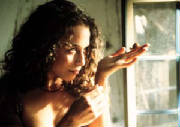|
Often labeled by her first film Brigitta,
Knöpfel has produced other works in mass media and the film industry such as the film she collaborated on entitled Requiem für eine romantische Frau (1999). She won best production in a Bayern Film Festival. The film also won
the Max-Ophüls award for best script and actress. This film is about a love affair of a woman and poet, who live life in true
romantic literature fashion yet must face the rejection of a society hell-bent on upholding traditional standards for women.
The film was awarded the Hesse Film Prize of 1998.

Her recent work is: Durch diese Nacht sehe
ich keinen einzigen Stern (2005); originally released for television in 2000. Knöpfel
directed this film, Through this night
I don’t see any stars. It is most definitely based on real subjects and events through which the characters on screen
portray in this love-drama film. It is a story about a woman who sets out to “make it on her own” in a society
not willing to relax the archetypical role of a woman in the 19th century.

Take the Dagmar challange!
1. What award did Dagmar win at the Bayern Film Festival?
2. What was the name of Dagmar’s first film?
3. Who was Dagmar inspired by?
4. What is the name of Dagmar’s hometown?
5. What is Dagmar’s last name?
Answers
Durch diese Nacht sehe ich keinen einzigen Stern
Purchase her movies
Dagmar Knöpfle's home town
"Whenever I hear people talking about 'liberal ideas,' I am always astounded that men should love
to fool themselves with empty sounds. An idea should never be liberal; it must be vigorous, positive, and without loose ends
so that it may fulfill its divine mission and be productive. The proper place for liberality is in the realm of the emotions."
--
Johann Wolfgang von Goethe (1749-1832)
|




